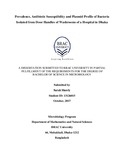Prevalence, antibiotic susceptibility and plasmid profile of bacteria isolated from door handles of washrooms of a hospital in Dhaka
Abstract
ABSTRACT:
Background: The fomites can serve as vehicles in transmission of pathogens. This study was conducted to determine the bacterial contamination in door handles of washrooms of a hospital, to determine the prevalence and antibiotic susceptibility pattern of the isolates. Plasmid profile was done to observe the presence or absence of plasmid among isolated bacteria from door handles of washrooms of a hospital.
Methods: Washrooms of four different wards of a hospital were included in this study. Sixteen (16) swabs were taken from sixteen (16) door handles. Bacterial identification was carried out by different biochemical tests according to Bergey’s Manual of Systematic Bacteriology and antibiotic susceptibility test was done by Kirby-Bauer method. Plasmid extraction was done according to modified hot alkaline method.
Results: Out of the 16 samples processed, 16 (100%) of them showed bacterial growth. A total of forty three (43) isolates were obtained. The bacteria isolated were Staphylococcus spp. (37.21%), Bacillus spp.(18.6%), E. coli.(16.28%), Fecal Coliform (13.95%), Micrococcus spp.(6.98%), Pseudomonas spp.(4.65%), Klebsiella spp.(2.33%).Plasmid profiling revealed (11 out of 43) bacterial isolates contained 1 or more plasmids with different profiles.
The isolated bacteria showed varying susceptibility pattern to the antibiotics used and were all resistant to at least two antibiotics. Among the 43 isolates, 83.72% were found resistant to more than two antibiotics. Highest resistance percentage of the isolates was observed against Penicillin G (95.35%) followed by SXT (74.42%) and amoxicillin (65.12%), rifampicin (55.81%), tetracycline (18.60%), ciprofloxacin (23.26%), chloramphenicol (4.65%), gentamycin (2.33%) and streptomycin (6.98%).
Conclusion: Findings of this study indicate the presence of bacterial strains resistant to more than two antibiotics in door handles of washrooms of a hospital which can serve as potential source of diseases.

